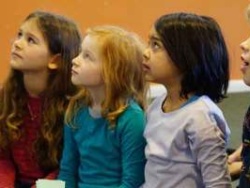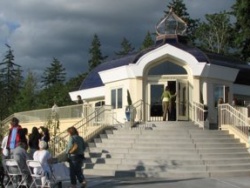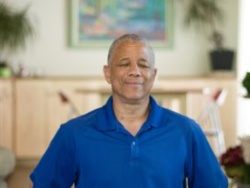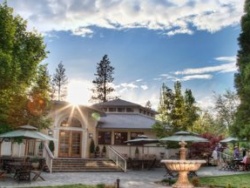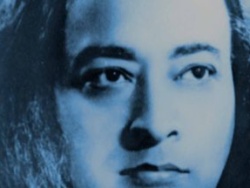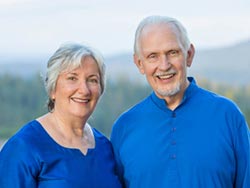I was born and raised in Memphis, Tennessee and attended the second largest Southern Baptist church in the world. I went to Baylor, which is a Baptist college in Texas, and when I graduated I moved to Houston and got a job working for an airline. I never felt in tune with what was being taught to me by the Baptists. I didn’t want to hurt my parents so I told myself I’d do what they want up to a certain point and then I’m on my own. They figured I’d marry a nice Baptist boy and settle down. I was the only one of all my college girl friends who graduated single.
I was already searching for answers about spirituality. I read Edgar Cayce’s books, and books written about Tibet and living in Tibetan Monasteries. Reading these books was like coming home, it all seemed so familiar. When I read Autobiography of a Yogi I was thrilled. It answered all my questions about the search for God. I tried to learn to meditate on my own, but wasn’t very successful. It never occurred to me that there might be other devotees with whom I could share my spiritual search.
About this time I was becoming interested in living in community. I’ve always had an interest in communes and communities and enjoyed reading books about utopias. In about 1971 I found a copy of the Spiritual Communities Guide that the Sufis used to publish. I found a small paragraph that described Ananda as a cooperative spiritual community in Northern California, founded by Swami Kriyananda, where everyone follows the teachings of Paramhansa Yogananda. I instantly wanted to visit. Back in Tennessee, my mother used to say that California is the land of fruits and nuts, so you don’t go there. Stay away from it. There’s pagans, cults and God-knows what! Not that I believed that, but I grew up in the South—in Tennessee and Texas, which was considered the Bible belt and very conservative.
I discovered a community called the Peaceable Kingdom that was in central Texas, not too far from Austin and Houston. The people who lived there were dedicated to arts and crafts and organic gardening. That’s where I got my interest in herbs. I first visited there for an herb society meeting and ended up living there for about five years. While I was there I was studying the SRF lessons. I still remember the first letter I wrote to Ananda, asking them to send me information on their community. I got a personal letter back from Kalyani inviting me for a visit.
Shortly afterwards, I found a little ad in Communities Magazine that said “Apprenticeship Program at Ananda Village, $55 a month.” That was in my budget. So I arrived here in the summer of 1975. Parvati picked me up from the Greyhound bus station in a little Volkswagen that the nuns owned together. She was mostly in silence and seemed very centered and austere. I had never met anyone like her. I was so excited to be coming to Ananda that I was bubbling over with hundreds of questions. I wanted to know all about the community. I’m probably getting my karma back now by working at The Expanding Light because people come here the same way I came, just wanting to know everything.
I was used to the country, but when I arrived at Ananda it was so rustic that it reminded me of a pioneer scene. It was Kirtani’s first summer here too. I asked her all about Swami Kriyananda, and she answered my questions. She was my first friend here, and we’ve always stayed close even though she lives in our Assisi colony now. We worked in the garden together. I loved working in the garden. I had a strong connection with plants before I came here, but working with Haanel and Shivani taught me how to garden with consciousness and how to tune into the nature spirits. It was a wonderful experience.
I pitched my tent in Apprentice Village which is where The Expanding Light is now located. There was a men’s section, a women’s section and a couples section in this area. I hadn’t been at Ananda more than 24 hours before I realized how alive Yogananda’s teachings were. People here were living it. The first sadhana I attended everybody was doing Yogananda’s Energization Exercises. I had been doing them on my own through reading the SRF lessons, but I wasn’t doing them right. All the things I had read in theory were being put into real life at Ananda. It was a revelation for me.
The monastery was practically all there was when I came here. I never became a part of it because I was married before I came here. I had a first marriage that was crumbling at that point and so it wasn’t appropriate for me. I never really wanted to be a nun, and even when I divorced and could have been a nun, I didn’t feel it was my destiny. I was kind of out of sync with everyone else here. I wasn’t really single, I wasn’t married, I wasn’t a monastic and I wasn’t a householder.
Shivani married Arjuna shortly before I first visited Ananda in 1975. She said something to me like, “I’m trying to learn how to be a householder.” I didn’t know what she was talking about. She said, “Well, I’ve been a monastic for years. I don’t know how to cook, I don’t know how to take care of someone, I don’t know anything. But it’s okay, I’ll learn. Arjuna and I are having a monastic marriage.” I was too polite to ask her what that meant. I thought that meant they were going to be celibate. In fact, for a whole year I thought that. After a while I realized that wasn’t what she was talking about. So later I asked her, “How would you define a monastic marriage?” She said, “It’s really quite simple, you just put God first. Your marriage is for each of you to support each other, but your spiritual search is first.” According to the Bhagavad Gita, that’s the highest definition of monasticism anyway. Monasticism doesn’t have anything to do with your marital status or celibacy. It was a new concept to me that made a lot of sense. Swami has always developed that theme, so when I married Sudarshan I felt very comfortable with that concept too.
I met my husband Sudarshan here. He was on the staff at the Seclusion Retreat. He was the maintenance man and I was the cook. We had an interesting courtship because people in those years didn’t have courtships. The theme at Ananda in the early years was very monastic. Many of the householders here complained about feeling like second class citizens because there was such an emphasis on the monastery. If the householders felt de-rated, imagine what it was like to just try and explore whether you wanted to get married or not. I always felt like I was sneaking around. It was funny because many of us came from the “hippie free-love” generation and all of a sudden we were living in this monastic community. It was certainly a contrast.
Sudarshan and I talked a lot about relationships. At that time, Swami was giving a class on How to Spiritualize Your Marriage. At the end of the class he asked for questions, and Sudarshan and I were sitting together. It was one of the first times we had sat together in public and when you did, of course you knew everybody knew something was going on. He raised his hand and said, “Swami, you always talk about spiritualizing marriage. Could you talk about spiritualizing the dating process?” I just about crawled under my chair. Swami just looked at him and smiled. And he said, “You know I don’t have any experience so I just can’t speak to that at all.” Then he stopped for a minute and said, “Well, it’s just like everything else, you put God first.”
We talked it over and realized Swami didn’t have any ideas so we had to invent a way to spiritualize the dating process ourselves. One of the things we decided that we should do was to meditate together. Every Sunday morning we got together and meditated for a couple of hours before Sunday service. At that time, Sudarshan was in charge of the Ananda Press and I was managing the office at the Seclusion Retreat. We were both real busy as usual, so even seeing each other or taking a hike together was rare. We were married by Swamiji on August 17, 1980.
In our marriage we’re very supportive of each other. When one of us is down, the other tries to pick him or her up. Sudarshan is a very strong meditator, but I have my ups and downs. He has always been very sweet about not chastising me for not meditating enough, but always encourages me. And so encouraging each other is what makes such a big difference spiritually. Having someone to talk things over with makes a big difference. Often we’ll listen to talks by Swami in which he brings forth new ideas. It has been wonderful to have someone to bounce ideas off of while knowing that they are as completely loyal and dedicated as you are. Not that we question Swami, but often we are trying to more fully understand some of the new (to us) concepts he is presenting.
I really cherish our marriage. If you want to have a spiritual marriage, I would recommend both partners having a real strong relationship with God first. Try to be sure that the person you’re going to marry is as strong or stronger than you are on exactly the same spiritual path. After my first marriage, I wasn’t about to get married to somebody who wasn’t absolutely committed to this particular path. Being in a spiritual community is helpful. There were already good examples here of strong married couples living a spiritual life, so we weren’t the first to explore marriage. Two or three times when we did have some problems, as all couples do, we could go and talk to other couples who were ministers.
Service is a major component of living the spiritual life here. At Ananda, as with many religious traditions, your religion is not just practiced on Sundays. It’s not just something you do occasionally. You need to have an outlet for it. It’s hard for me to conceive of two people who were strongly dedicated meditators, and all they did was meditate together. Anyone on a serious spiritual path needs to have a way of giving, of serving.
Service keeps the flow of love going and keeps you from getting stagnant. I think Yogananda set it up so that if you’re going to be on this path and be successful in your spiritual life, you have to serve. Service is like water. God pours the water of grace and love into you and you have to give it back out again. Swami uses the image of a spring—if you don’t keep the weeds cleared and the outward flow going, then it just doesn’t work.
Most people think of a job as a 9 to 5 experience where you go home and have your own life after the clock stops. At Ananda, it’s set up so there’s many ways to serve. You can help lead a study group in the evenings or participate in workdays. Every department and every business here always needs more volunteers. When there’s something important that needs to be done in the community, like a workday, I’ve learned to put aside my own desires and needs and concentrate on the project at hand. This is often the way we’re able to pull off big events here. I know this thought came to me when I first came here: “I have a college degree. What am I doing here washing dishes?” But it’s what was needed in order to make the whole thing happen.
The magnetism builds when you can feel your oneness as devotees doing something together. It’s a thrilling feeling. That’s what happens at our annual Rajarshi Day. Hundreds of people come together here to help build walkways, paint buildings, or do landscaping, for one entire day in May. People just love it. There’s a magnetism that grows when people put their energies selflessly in a certain direction. It’s called karma yoga—seeing God in your work and not being attached to the fruits of your labors. Work should be done without thinking about what you’re getting from it. You set your desires aside and let the joy of God’s energy flow through you without worrying about whether anybody is helped or if anything is happening.
When I first came here I didn’t know who Swami Kriyananda was, so I asked Kirtani, “Is he the Guru here?” She said, “Oh no. He’s a disciple of Yogananda. He lived with Yogananda before Yogananda died.” She told me the story. That helped me because I was kind of fearful that I would come here and there would be this guy up on the throne who would say, “Bow to me, give me all your worldly goods, because if you want to check in here that’s what you’ve got to do. You have to do everything I say, too.” I wouldn’t have stayed if that was the case because I’m too independent. The first time I saw Swami Kriyananda was a week after I got here. He was giving a class at the Seclusion Retreat. I was absolutely thrilled to my toes, because he was so eloquent and funny, open and natural.
Before I came here, I knew enough about communities to know that the community is the reflection of the leaders. The people I met here were such high quality people. I could actually see the light in their eyes and their faces. I figured it was Yogananda’s blessings, but I also figured they were getting the right guidance because I’d lived in communities before and had seen what happens.
One of the first things I heard Kriyananda say in that first talk I heard him give, because I suspect he was actually tuning into my question, was, “I’m not the guru. I’m a follower of Paramhansa Yogananda and a disciple. However, I have had years of experience on this path and I’m happy to share that with you. So if you are interested in that, then I’m happy to be that to you.” So for awhile I thought of him as a brother disciple on this path. As I got to know him better, I was in awe of his spiritual stature. I still hold him in great awe and wonder because of his spirituality and all the things he does. His leadership capabilities are beyond belief. Besides meditation, a significant part of my sadhana is listening to tapes of Kriyananda’s talks. I have hundreds of them and I listen to them constantly. I do that for two reasons. One, because I teach all the time, so it helps me be a better teacher. The other is just to attune myself to him so, to Master and to this ray of energy represented through Ananda.
Attunement is like a musical term—like when you’re trying to tune a guitar. You try to harmonize your vibration, to get on the same wavelength, so to speak. If you want to be a good airline pilot, you hang around the best airline pilot there is because there’s more to it than just learning from books. What you learn from someone is quite often not something that comes through words, it’s done by the exchange of energy and electro-magnetic energy and magnetism. When you’re in the proximity of someone who you suspect is a person of high spiritual stature, be it a saint or be it a spiritual teacher, you benefit by putting down your own barriers and opening yourself in some way to receive, not just their words, but their energy and their vibrations. And that’s what I’ve always tried to do with Swami Kriyananda.
I’m a person who loves nature. The physical setting of Ananda is totally inspiring to me so I spend a lot of time in nature. I love taking walks, talking to friends, and sitting around the dinner table.
I enjoy the simple pleasure of community living—like the talks after dinner with friends. It’s very important because it’s satsang on a human level. During these times, all sorts of things come out, funny stories, lots of laughter. I think one of the most wonderful things about Ananda is the laughter and joy we’re able to keep through all our trials. There’s a level of humor here that is quite healing—you see it in our plays, the music and the way we interact. I think a lot of people take themselves way too seriously. And of course, Swami has lead the way in that. He laughs at himself, he laughs at P.G. Wodehouse, he laughs at many things.
There have been hundreds of utopia-type communities in this country, some which still exist. We’re not the only intentional community, but we are unique. I believe Ananda has succeeded where many others haven’t because of Swami Kriyananda’s leadership, because of Yogananda’s blessings, and because the first thing we did was to open a retreat where other people could visit and we could serve them. I think it’s important for communities to serve the greater world in some way. I think Ananda is successful because we have always thought in terms of what we can do to serve others and not just try to create a happy little life for ourselves and our families.
Guests come here and their consciousness is uplifted without them even knowing what has happened. They’re vibrating at one level when they get here and they’re vibrating at a different level when they leave. That’s due to a lot of different things. Mainly it’s the laws of satsang, of magnetism, and there’s a “joy zone” here that people get just by physically walking into it. The delivery men that come here comment on it. Sudarshan says that the guys who deliver to our job sites tell him they just like coming here, they don’t know why. It’s peaceful here. People come here and think we have some of the most beautiful gardens they’ve ever seen. And I realize that what they’re responding to is something else—it’s not really the gardens, it’s the love and the energy that’s expressed here.
When a large number of people are focusing their energy in the same direction, they create a magnetism—through meditation, through service, through their love for mankind and nature. The grace that people feel here is the blessings from our guru, Yogananda. I’ve looked at this place all these years and thought, “How could it keep going, how could it survive?” It has to be the grace of God, because it just doesn’t work on paper. There have been so many miracles here that I cannot explain.
There was once a lady who came to our Elderhostel program—she was a large woman, in her seventies, athletically built, but she walked kind of slowly. She had some health problems and she was discouraged about her life. We taught her Energization Exercises and the simple stretches that we do for Elderhostel guests. At the end of her five days here, she came to me with tears in her eyes. She said, “You know I was ready to die and had given up on my life. I had nothing to live for. I couldn’t use my body in the way I used to. I was always active and athletic. You have given me back my life.” Swami has always told us that the greatest thing we can do is to give people our love and energy—that’s the main thing they’ll remember and benefit from the most.
What we do at Ananda is to try to live spiritual principles to the best of our ability by walking our talk and not making spirituality some kind of philosophy that you read in a book. A lot of it has to do with meditation. Years ago I remember just reading and reading and reading. And one day I just threw whatever book I was reading across the room—it might have been Autobiography of a Yogi—because I’d read it so many times. I thought, I can’t read it anymore, I have to do it, I have to experience it. Ananda is that for me—a living laboratory for spiritual theories.
Every day is a lesson for me in learning how to trust God more. How to trust that everything is going to be okay; no matter if it doesn’t look like it’s going to be okay, it’s still going to be okay. There have been a lot of small things where I personally haven’t had enough money to get my teeth fixed or something, and somehow it always comes to me.
One interesting story was when I was first driving out here to Ananda. I was in West Texas and became sick and couldn’t go any further. I had some kind of stomach flu so I couldn’t drive and didn’t have enough money for a motel. I was stuck in the desert. I began really praying to God to help me. I kept clearly getting the message, well just try going a little further. When I arrived in Las Cruces, New Mexico, I again prayed to figure out what to do. I saw these two girls standing over on the side of the road hitchhiking in the middle of the desert. One had a guitar case. Yogananda had always said, “Don’t pick up hitchhikers.” I thought, well, no, wait a minute, this may be God answering me somehow.
I drove over to where the girls were and asked them if they were trying to get a ride somewhere. They said, yes, they were looking for a ride to Sacramento, California. I said, “Can either of you drive, because I’m not feeling well.” One said, “I have a chauffeur’s license. That’s what I do for a business.” So they hopped in and drove me all the way out here. This to me was like an angel story. And the interesting thing was that they had been praying that somebody would come along and pick them up! That’s a wonderful answered prayer story. When I told everybody here about my story they said, “Oh, stuff happens here all the time.” It’s the land of miracles.
Prayer and trust in God helps you have faith in God. You can’t learn faith any other way than by having the experiences come along. I’ve seen things like this happen too many times not to know that it’s God’s grace. My faith gets stronger when I come up against something and begin thinking I’m just not going to make it this time. Then I remember back on all the miracles and all the things that shouldn’t have worked out but did. The grace of God and the blessings of Yogananda definitely take up the slack.



